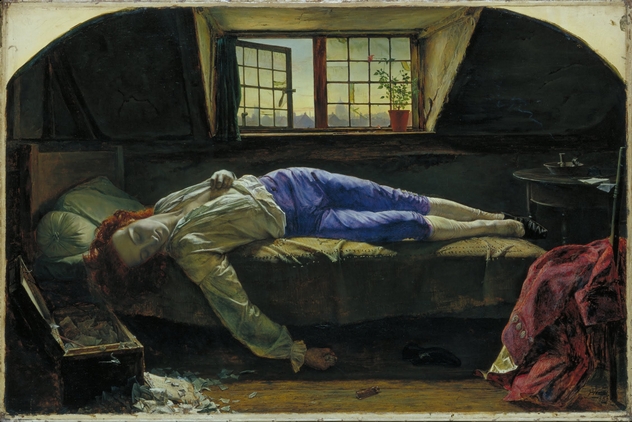 Our World
Our World  Our World
Our World  Pop Culture
Pop Culture 10 Incredible Female Comic Book Artists
 Crime
Crime 10 Terrifying Serial Killers from Centuries Ago
 Technology
Technology 10 Hilariously Over-Engineered Solutions to Simple Problems
 Miscellaneous
Miscellaneous 10 Ironic News Stories Straight out of an Alanis Morissette Song
 Politics
Politics 10 Lesser-Known Far-Right Groups of the 21st Century
 History
History Ten Revealing Facts about Daily Domestic Life in the Old West
 Weird Stuff
Weird Stuff 10 Everyday Products Surprisingly Made by Inmates
 Movies and TV
Movies and TV 10 Actors Dragged out of Retirement for One Key Role
 Creepy
Creepy 10 Lesser-Known Shapeshifter Legends from Around the World
 Our World
Our World 10 Science Facts That Will Change How You Look at the World
 Pop Culture
Pop Culture 10 Incredible Female Comic Book Artists
 Crime
Crime 10 Terrifying Serial Killers from Centuries Ago
Who's Behind Listverse?

Jamie Frater
Head Editor
Jamie founded Listverse due to an insatiable desire to share fascinating, obscure, and bizarre facts. He has been a guest speaker on numerous national radio and television stations and is a five time published author.
More About Us Technology
Technology 10 Hilariously Over-Engineered Solutions to Simple Problems
 Miscellaneous
Miscellaneous 10 Ironic News Stories Straight out of an Alanis Morissette Song
 Politics
Politics 10 Lesser-Known Far-Right Groups of the 21st Century
 History
History Ten Revealing Facts about Daily Domestic Life in the Old West
 Weird Stuff
Weird Stuff 10 Everyday Products Surprisingly Made by Inmates
 Movies and TV
Movies and TV 10 Actors Dragged out of Retirement for One Key Role
 Creepy
Creepy 10 Lesser-Known Shapeshifter Legends from Around the World
10 Notable People Who Chose To Take The Poison
Socrates is probably the most famous example of a person making a considered choice to take their own life through poison. In his case, it was either hemlock or exile, and the Greek philosopher—some would say foolishly—went for the hemlock option. But there were plenty of other people who, for reasons that were sometimes noble and sometimes otherwise, chose to take poison.
10Madge Oberholtzer

David Curtiss Stephenson was one of the most reprehensible men in the Ku Klux Klan, itself a reprehensible organization. By the early part of the 1920s, he had risen to “Grand Dragon” (state leader) status and was a hugely powerful individual. However, Stephenson’s relationship with a young woman named Madge Oberholtzer would lead to his downfall and effectively destroy the Klan in the state of Indiana.
The young schoolteacher and the KKK Grand Dragon dated for a short while, until Madge decided to break it off. Stephenson, who had ties with the State Governor and believed himself to be above the law, reacted in a way he probably thought quite reasonable: He kidnapped Madge at gunpoint. Stephenson and his cronies took her to a railway carriage where she was repeatedly raped and bitten so badly that a doctor would later say it looked as though she had been attacked by a cannibal.
Even after the initial attack, Stephenson wasn’t quite finished, and he took Madge to a hotel where he forced her to check in as his wife. Madge later convinced one of Stephenson’s henchmen to accompany her while she purchased some rouge, but her real intention was to get some mercury chloride tablets. Soon, she had taken six tablets and was vomiting blood, but Stephenson still refused to take her to a hospital unless she married him.
Sadly, Madge didn’t manage to survive her ordeal, but she did live long enough to give her statement to the police. Stephenson was jailed for life, and the membership of the KKK in Indiana fell from a high of 500,000 to just 4,000 in the three years after the scandal.
9The Poison King

Mithridates was a descendant of Alexander the Great and an enemy of Rome to rival Hannibal or Spartacus. He was still a child when he became King of a small land called Pontus, in modern-day Turkey, after his father had very possibly been poisoned to death by his mother. Eager to avoid falling victim to the same fate, Mithridates ran away at a young age. He then took the precaution of rendering himself immune to poison by ingesting small quantities on a regular basis.
The “Poison King” soon clashed with Rome, and he proved himself to be a skillful tactician and a terrible foe. In one of his early battles, Mithridates executed a defeated Roman general by pouring molten gold down the man’s throat. Throw in a few massacres, and it was clear to Rome that the Poison King meant business.
It took 40 years and Rome’s finest military mind in Pompey the Great to finally subdue Mithridates. Realizing he was beaten, Mithridates attempted to commit suicide by poison. It didn’t work—his immunity was too strong. The 69-year-old king instead commanded his personal bodyguard to run him through with a sword.
8Bill Haast
In addition to his role as an almost-forgotten historical figure, Mithridates’s name lives on through the practice—albeit an incredibly niche practice—of “mithridatism.” This refers to the method of self-administering poison in ever-increasing doses in the attempt to ultimately render the body immune to the toxins. One of the few Western adherents was an American named Bill Haast, a man who took on the unusual challenge of cobra-proofing his blood by repeatedly injecting himself with venom.
Having been obsessed with reptiles from a young age, in 1947 Haast opened the Serpentarium, a snake farm and popular tourist attraction in Miami. Since the Serpentarium housed more than 500 venomous snakes, which Haast handled regularly, a degree of immunity to their bites would certainly be helpful. Over the course of his lifetime, Haast was bitten 172 times; one such occasion led to him having his wife chop off his finger with pruning clippers to prevent the poison spreading through his body. His finger had turned black, hinting that immunity to cobra venom didn’t necessarily translate to other species of snake.
Haast closed the attraction in 1984, following a tragic accident where a young boy was attacked and killed by the Serpentarium’s crocodile. However, Haast continued to work closely with reptiles, and doctors were even able to use his blood as antivenom to save the lives of several snakebite victims. Haast lived to be 100 years old, and some attribute his longevity to the venom he injected. It may have worked for Haast, but the prevailing opinion among health professionals remains unchanged: Snake venom and the bloodstream are best kept separate.
7Hermann Goering

The morphine-addicted Hermann Goering was one the most powerful men in Hitler’s Third Reich. While most of the other top Nazis committed suicide before they were discovered, Goering was forced to stand trial. Facing charges of waging aggressive war, murder and enslavement of civilians, plunder of property, and war crimes, Goering still managed to put on a show of defiance from the dock. He emerged clear winner in the opening exchanges with the American chief prosecutor Robert Jackson, with Jackson even throwing down his headphones in frustration and refusing to continue. However, all of Goering’s posturing and cunning couldn’t disguise the fact that he was guilty.
Having been sentenced to death, Goering demanded the right to be executed by firing squad. During World War I, he had been a brave and highly decorated combat pilot; he believed he had earned the right to die like a soldier rather than being hanged like a common criminal. The court disagreed.
The man who had once been designated Hitler’s successor had one last trick up his sleeve. Just hours before his execution, he committed suicide in his cell by swallowing a cyanide capsule. The note he left for the Allies declared that he felt no obligation to submit to his enemies’ punishment. Whether Goering had managed to conceal the cyanide on his person or it had been given to him by a sympathetic guard, we will probably never know for sure.
6Thomas Chatterton

Born in Bristol in 1752, Thomas Chatterton was a romantic poet who led the sort of short and tragic life that poets probably prefer to write about rather than endure. During his early years, he showed no inclination for the love of words which would come to define his future, and he was even regarded as something of a dullard. However, this soon changed. He fell in love with writing poetry, and he wanted everybody else to love his poetry, too.
The poems were good. So good that Chatterton had a great deal of difficulty convincing anyone that he had written them himself. His solution was to add forgery to his list of talents, and he began passing off his work as the creations of a fictitious 15th-century priest he named “Sir Thomas Rowley.” In this manner, Chatterton was able to achieve a taste of the acclaim he sought, albeit in another’s name.
At the age of just 17, Chatterton set out for London with dreams of fame and fortune. He succeeded in selling a few poems and satirical works but not enough to support himself. In a cautionary tale for would-be writers, Chatterton soon found himself alone and starving. Rather than return to Bristol and admit that he had failed, the young romantic poet chose to commit suicide by drinking arsenic. Only after his death would his poetry receive the kind of recognition he had always craved.
5Fumimaro Konoe

Prime Minster Fumimaro Konoe was something of an anomaly among the aggressively nationalistic Japanese government in the run-up to World War II. He spoke two Western languages (German and English), adored the work of Oscar Wilde, harbored Marxist sympathies, and was desperate to avoid a war with the United States. Unfortunately, the real power in Japan lay not in the hands of the Prime Minister but the military elite, and they were already wed to the dangerous idea of delivering an almighty kick to the sleeping giant that was America. Unable to deflect his nation from its collision with the United States, Konoe resigned from his position in October 1941. Less than two months later, on December 7, 1941, the military launched their surprise attack on Pearl Harbor, plunging Japan into a war with the world’s foremost economic superpower.
In the words of the Japanese Emperor Hirohito as he confirmed his nation’s surrender in 1945, “the war situation has not developed necessarily to Japan’s advantage.” Konoe, however, hoped to play his part in the postwar rebuilding process. These hopes were dashed when General MacArthur, the man America had placed in charge of postwar Japan, named Konoe as a possible war criminal. Although he acted laudably in attempting to prevent war between Japan and America, Konoe’s record elsewhere was less than impeccable. He had played an important part in politically aligning Japan with Nazi Germany and had been Prime Minister as Japan waged a brutal war against China. During this war, Japanese troops committed appalling atrocities, such as the rape of Nanking, in which as many as 300,000 civilians were massacred.
Konoe would never face trial; instead, he decided to swallow a capsule of cyanide. This in itself was a slightly unusual choice for a man who came from a family steeped in samurai tradition. A more respected method of self-dispatch for the higher echelons of Japanese society was seppuku—a grisly form of ritual disembowelment.
4Magda Goebbels

As the beautiful wife of infamous Propaganda Minister Joseph Goebbels, Magda was one of the most famous women in Nazi Germany. She was also a committed National Socialist, and as the Red Army entered Berlin in April 1945, Magda and her husband decided to take their six young children and move into the Fuhrerbunker to be close to Hitler when the end came.
Many Nazis committed suicide as the Reich crumbled, but Magda’s case was far more shocking, as she not only killed herself but her children, too. Her eldest son was a Luftwaffe pilot held in a POW camp in North Africa, and Magda wrote him a letter explaining that the world which would come after Hitler wouldn’t be worth living in. Everything beautiful and marvelous that she had known was ruined.
Magda’s decision to kill her children came in spite of an offer from Albert Speer, a powerful man in what was left of Nazi Germany, to have them smuggled out of Berlin. Hitler’s doctor administered the poison, then Magda and Joseph walked to the bomb-cratered garden, each bit down on a capsule of cyanide, and an SS officer delivered a bullet to their heads just to make sure.
3Michael Marin
It looked as though Michael Marin had everything. The Yale graduate lived in a mansion worth $2 million, drove a Rolls-Royce, and piloted his own plane. However, he’d purchased his house in 2008, just before the American property market crashed, and by 2009 he could no longer afford the mortgage and stood on the verge of bankruptcy.
Unable to see any other way out, Marin decided to burn down his house and claim the insurance money. Having set the blaze, he used a rope ladder to climb down from a second-floor window while wearing a scuba suit and an oxygen tank. This rather bizarre escape did him no favors, as it immediately aroused the suspicion of the Fire Department investigators. The case went to court, and Marin was facing 16 years in prison for arson. He placed a capsule in his mouth. Minutes later, he collapsed to the ground and was pronounced dead on arrival at the hospital. An autopsy would later confirm that Marin had died of cyanide poisoning.
2Bando Mitsugoro VIII
 Kabuki is a type of dance drama which is a pretty big deal in Japan. One of its most famous practitioners was Bando Mitsugoro, considered important enough by the Japanese government to be awarded the status of “living national treasure” in 1973. Within a couple of years of this honor, Mitsugoro would be dead after knowingly consuming poison.
Kabuki is a type of dance drama which is a pretty big deal in Japan. One of its most famous practitioners was Bando Mitsugoro, considered important enough by the Japanese government to be awarded the status of “living national treasure” in 1973. Within a couple of years of this honor, Mitsugoro would be dead after knowingly consuming poison.
The poison in question can be found in the liver of the fugu fish, or the blowfish, as it is more commonly known in the West. It’s said to be more deadly than cyanide, with the victim first suffering numbness around the mouth, generally followed by paralysis and death. Much of the poison is located in the fish’s liver. While enjoying a meal with friends, Bando Mitsugoro boasted that he was immune to its effects. To prove his point, he then consumed four portions of fugu fish liver.
After seven hours of paralysis and convulsions, during which he was conscious and able to reflect on just how foolish he had been, Bando passed away.
1Erwin Rommel

Rommel was one of the most famous generals of World War II and, for a long time, one of Hitler’s favorites. With the Western Allies preparing an invasion of occupied France, Hitler looked to Rommel as the man to throw them back into the sea. It proved to be an impossible task, and once it was clear that the Allies had firmly established themselves on the western front, Rommel came to realize the war was lost. It was a conclusion shared by a great many others but not Adolf Hitler, who remained in thrall to his own supposed genius and believed he would yet master the situation.
The bomb that had been intended to kill Hitler exploded on July 20, 1944. Having survived the assassination attempt, Hitler was more convinced than ever that he was destined for victory. But first he needed to round up the plotters. Rommel hadn’t been actively involved in the attempt against Hitler’s life, but he probably had known about it, and that was enough to seal his fate.
Rommel, who had been recovering at home after being wounded by an Allied aircraft, was visited by two generals who offered him a stark choice: He could face trial where he and his family would be branded as traitors, or he could take poison and be given the funeral of a hero. Having received assurances that his family would be spared, Rommel chose to take the poison.
James Friend has finally opened a Twitter account. You can follow him here so he feels less lonely.








